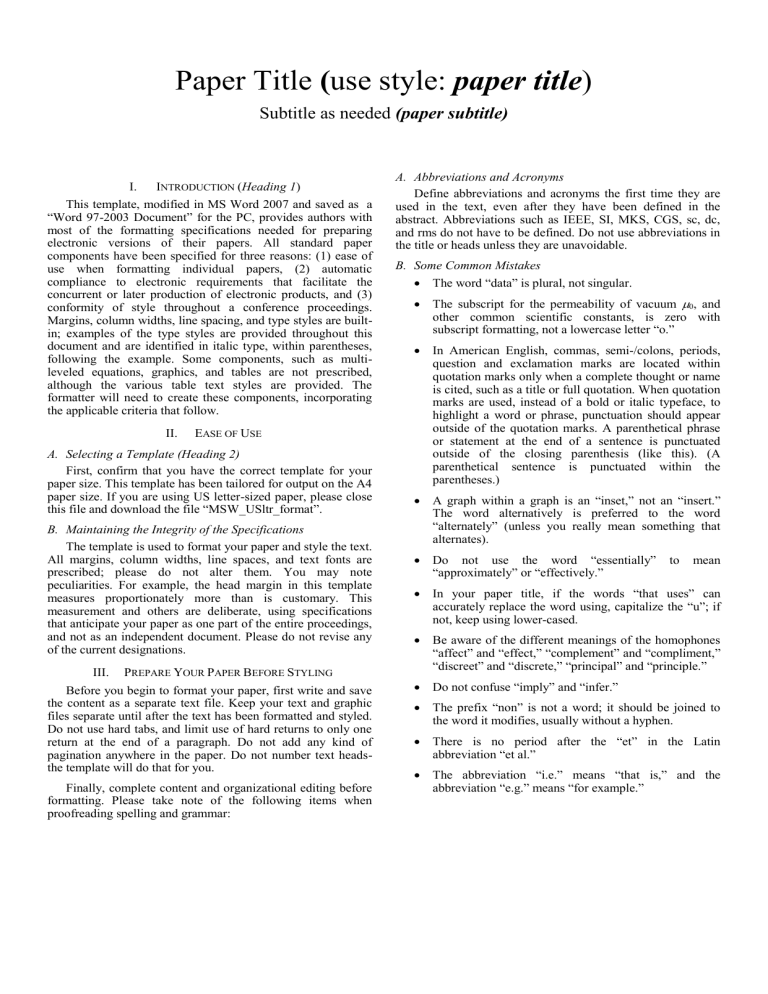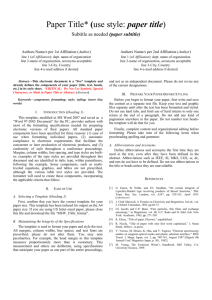Paper Title (use style: paper title)

Paper Title
(
use style: paper title )
Subtitle as needed (paper subtitle)
I.
I NTRODUCTION ( Heading 1 )
This template, modified in MS Word 2007 and saved as a
“Word 97-2003 Document” for the PC, provides authors with most of the formatting specifications needed for preparing electronic versions of their papers. All standard paper components have been specified for three reasons: (1) ease of use when formatting individual papers, (2) automatic compliance to electronic requirements that facilitate the concurrent or later production of electronic products, and (3) conformity of style throughout a conference proceedings.
Margins, column widths, line spacing, and type styles are builtin; examples of the type styles are provided throughout this document and are identified in italic type, within parentheses, following the example. Some components, such as multileveled equations, graphics, and tables are not prescribed, although the various table text styles are provided. The formatter will need to create these components, incorporating the applicable criteria that follow.
II.
E ASE OF U SE
A.
Selecting a Template (Heading 2)
First, confirm that you have the correct template for your paper size. This template has been tailored for output on the A4 paper size. If you are using US letter-sized paper, please close this file and download the file “MSW_USltr_format”.
B.
Maintaining the Integrity of the Specifications
The template is used to format your paper and style the text.
All margins, column widths, line spaces, and text fonts are prescribed; please do not alter them. You may note peculiarities. For example, the head margin in this template measures proportionately more than is customary. This measurement and others are deliberate, using specifications that anticipate your paper as one part of the entire proceedings, and not as an independent document. Please do not revise any of the current designations.
III.
P REPARE Y OUR P APER B EFORE S TYLING
Before you begin to format your paper, first write and save the content as a separate text file. Keep your text and graphic files separate until after the text has been formatted and styled.
Do not use hard tabs, and limit use of hard returns to only one return at the end of a paragraph. Do not add any kind of pagination anywhere in the paper. Do not number text headsthe template will do that for you.
Finally, complete content and organizational editing before formatting. Please take note of the following items when proofreading spelling and grammar:
A.
Abbreviations and Acronyms
Define abbreviations and acronyms the first time they are used in the text, even after they have been defined in the abstract. Abbreviations such as IEEE, SI, MKS, CGS, sc, dc, and rms do not have to be defined. Do not use abbreviations in the title or heads unless they are unavoidable.
B.
Some Common Mistakes
The word “data” is plural, not singular.
The subscript for the permeability of vacuum subscript formatting, not a lowercase letter “o.”
0
, and other common scientific constants, is zero with
In American English, commas, semi-/colons, periods, question and exclamation marks are located within quotation marks only when a complete thought or name is cited, such as a title or full quotation. When quotation marks are used, instead of a bold or italic typeface, to highlight a word or phrase, punctuation should appear outside of the quotation marks. A parenthetical phrase or statement at the end of a sentence is punctuated outside of the closing parenthesis (like this). (A parenthetical sentence is punctuated within the parentheses.)
A graph within a graph is an “inset,” not an “insert.”
The word alternatively is preferred to the word
“alternately” (unless you really mean something that alternates).
Do not use the word “essentially” to mean
“approximately” or “effectively.”
In your paper title, if the words “that uses” can accurately replace the word using, capitalize the “u”; if not, keep using lower-cased.
Be aware of the different meanings of the homophones
“affect” and “effect,” “complement” and “compliment,”
“discreet” and “discrete,” “principal” and “principle.”
Do not confuse “imply” and “infer.”
The prefix “non” is not a word; it should be joined to the word it modifies, usually without a hyphen.
There is no period after the “et” in the Latin abbreviation “et al.”
The abbreviation “i.e.” means “that is,” and the abbreviation “e.g.” means “for example.”





